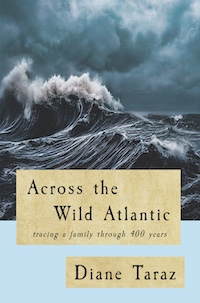Across the Wild Atlantic --
Tracing a Family Through 400 Years
Click here to order at Amazon.com.
Diane roams through four centuries to discover the journeys of her ancestors who, along with millions of others, came to this country in search of a better life. It is filled with photographs and images, many in color, and a wealth of surprising details about life as it was lived long ago.
My mother's people sailed from France to the colony of New France, now the province of Quebec in Canada. They fought the Iroquois, they fought to survive the long winters, they fought to grow crops in the stony soils, and they fought invaders from New England. In the 1920s my grandparents emigrated to find work in the booming textile mills of Massachusetts. Their experiences encompass the immigrant experience in all its troubles and joys.
My father's father left Poland as a youth, escaping being drafted into the Russian Army to fight World War I. His homeland had been fought over for a thousand years and had long been occupied by foreign powers who made life miserable. He and others in his family fled poverty and oppression, making an arduous journey to form new communities, free from efforts to erase their language and culture. They, too, found work in the mills.
This search through time posed many challenges, and I am grateful to my husband, John, for overcoming so many of them. He untangled a host of records and is familiar with the language of officialdom in French, Polish, German, Russian, Hebrew, and Latin, much of it hand-written, and some of it in cursive. He proofread my manuscript, catching errors in dates, names, and facts, with good cheer. He also scanned and repaired photographs, many of which has spent the last 70 years or so in boxes or albums that were decidedly not archival.
We made it back nine generations, and by then one has some 2,048 ancestors, many with the same names. I am familiar with French and its accents, and John is a whiz at the marks that affect pronunciation in Polish, which is a thicket of consonants. Together we pored over artifacts from the past and teased out what they show about individuals and the world in which they lived.
The dry facts of births, marriages, and deaths are enlivened by information about what was going on around the people in question, in their households and villages, and in the wider world. I love the domestic history of what people ate, what they wore, how they raised their children, what they believed, the traditions and customs they kept, and how they treated one another.
This is the story of one family, sailing on the currents of history. The details of their everyday lives form a fascinating tapestry of culture, language, religion, social movements, and identity. Their experiences reflect those of so many others who came, and continue to come, to the land where Lady Liberty, despite everything, still lifts her lamp of hope.
